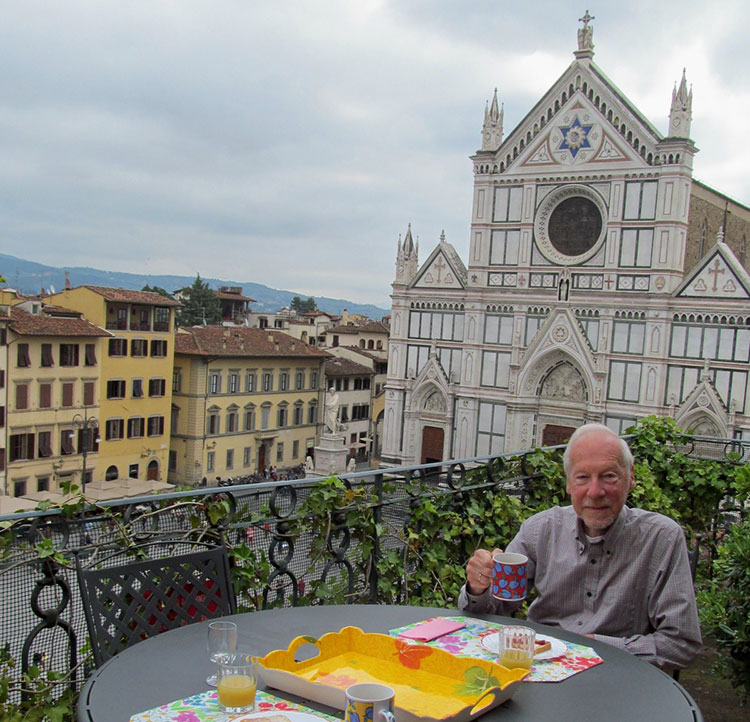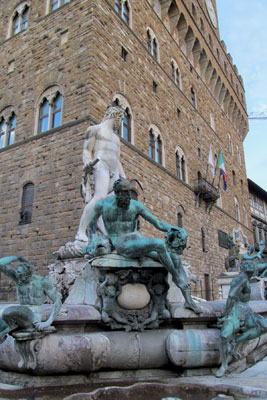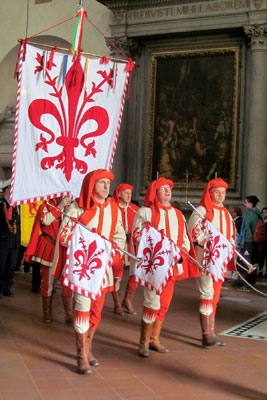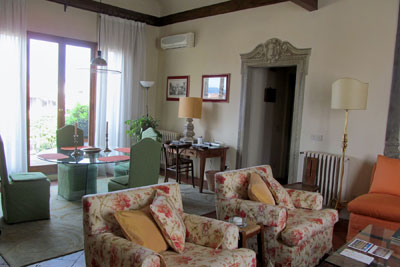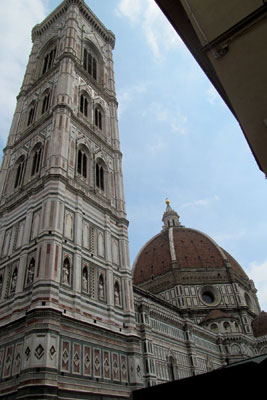Living like a royal in Florence, Italy
This article appears on page 20 of the September 2014 issue.
by Julie Skurdenis; Contributing Editor
My husband, Paul, and I are in love with Florence. This Italian city beside the Arno River ranks high among our favorite cities. It’s a love affair that began more than three decades ago and has continued over more than a dozen trips.
Palazzo living
Over the years, we’ve stayed in B&Bs, in modest, tourist-class hotels, in grand hotels and even, once, in a medieval tower apartment overlooking narrow, dark streets and the Ponte Vecchio. However, though Florence is a quintessential Renaissance city full of 400-year-old palazzi, we had never stayed in a Florentine palazzo. Paul and I thought it high time we did.
On a trip to Florence in October 2012, we “discovered” the Palazzo Antellesi and rented an apartment within it for three weeks. We enjoyed it so much, we decided to return in June 2014.
Palazzo Antellesi (Piazza Santa Croce 21/22; phone +39 055 24 44 56) boasts an ideal location on the Piazza Santa Croce, one of the best known of Florence’s many piazzas and the site of one of its most famous churches, Santa Croce. The palazzo is within walking distance of most of the Florentine sights on visitors’ “must see” lists.
But over and above its perfect location are the palazzo’s long history, its architecture and superb exterior decoration. Built in the mid-16th century by the wealthy merchant Del Barbigia family, it features unique sporti, projections supporting its upper floors, and a frescoed façade.
The frescoes were painted in the early 17th century for another family, the Dell’Antella family, from whom the palazzo takes its present name. Some of these 400-year-old frescoes still remain while others have been restored.
The Cinelli family bought the palazzo in 1925, and its present owner, Countess Federica Piccolomini (a member of the Cinelli family), still calls Palazzo Antellesi home.
Having it all
A portion of Palazzo Antellesi has been divided into 10 rental apartments. No two apartments are alike; some incorporate frescoes or architectural features from the original structure, many have working fireplaces, some have terraces or patios, some have views of the Piazza Santa Croce, others look out to the Tuscan hills or the church of San Miniato in the distance, and some have it all.
The latter was the case with the first apartment we rented in October 2012. It was called “Mimi” and included a large terrace, a fireplace and views in two directions. This 2-bedroom, 2-bathroom apartment was elegant and comfortable, and we lived there happily for three weeks.
When we returned in June 2014, we wanted to try another apartment. We chose “Miravista,” an apartment located on the same penthouse floor (accessible by elevator) as “Mimi.” It, too, had a living room and dining room (combined into one large room), a kitchen with a dishwasher and a washing machine, two bedrooms and two bathrooms plus an extra half bathroom for guests. It also had a fireplace and a terrace overlooking Piazza Santa Croce and the same incomparable views.
Among our favorite times in “Miravista” were those spent breakfasting on the terrace with the church of Santa Croce visible in one direction and the Duomo (Cathedral) and Campanile in the opposite direction; sipping a glass of Chianti with cicchetti (snacks) at the dining room table, with its views of the Tuscan hills, before going out to dinner; relaxing with a glass of grappa in front of the fireplace after dinner, and curling up in bed with a book, with the night sounds of Florence wafting up from the piazza. (There were no car or motorcycle noises, since the piazza is blessedly restricted to pedestrians.)
Dining in… and out
Sometimes we ate in, because what could be better than a dinner of a dozen assorted appetizers picked up at local food shops, added to a bowl of pappardelle or pici pasta, with a salad on the side and a bottle of Chianti Classico? And what could beat our nighttime view of twinkling lights in Fiesole, a Tuscan hill town located six miles north of Florence?
When we did go out to dinner, it was to Boccadama, a bistro/wine bar literally five steps from the palazzo’s front door. (Plates average €8-€14, or $11-$19.) This was our favorite Florentine restaurant on our first stay at the Palazzo Antellesi, and it remained our favorite restaurant on this visit.
One night, when it started raining, we stumbled into a modern trattoria called Trattoria Il Bargello (Borgo dei Greci), located two blocks from the palazzo. (Having no umbrellas, we needed shelter.) Mama ran the kitchen and papa reigned at the cash register when not serving the food. Locals were chowing down there — always a good sign.
On another night, strolling in Oltrarno on the other side of the Arno River, we found Golden View (Via de Bardi, 58/r), offering fabulous appetizers and an even more fabulous view of the Ponte Vecchio. After the appetizers (averaging €9-€18), there was no room for dinner.
One of the many joys of Florence is its cafés. Our favorite, Rivoire, sits on the famous Piazza della Signoria and is a prime people-watching spot. Across the piazza looms the stern-looking Palazzo Vecchio. Built in the early 14th century, it’s just one of the city’s many iconic buildings.
Two more favorite cafés are located in Piazza della Repubblica: Caffé Paszkowski (entrées average €15) and Caffé Gilli. They stand shoulder to shoulder like the venerated dowagers they are, except that these dowagers serve omelets anytime of day and sinful desserts as well as full meals.
In a different, more modest category is Caffé Ricchi, across the Arno, a long 30-minute walk or a 10-minute cab ride from the Palazzo Antellesi. Located in the unpretentious Piazza di Santo Spirito, Ricchi has both a small dining room and a delightful café lined with dozens of fanciful renditions of what the adjacent Brunelleschi church of Santo Spirito could look like if its austere façade were to be decorated.
City sights
When visiting Florence, if our stay was scheduled for four days, we’d say, “Why didn’t we plan a week?” If it was for a week, we’d bemoan the fact that we were not staying two weeks. If it was two weeks, it should have been, perhaps, a month. You get the idea.
Time planned in Florence is, for us, never enough. On our 2012 trip, we had three weeks and it wasn’t enough. On this 2014 trip, we had only a week at the tail end of a month-long journey through Tuscany and Umbria. We knew we’d be in trouble.
There was no way we could possibly squeeze in all the places we love in Florence in just one week, nor did we want to run around frenzied trying to do so, so in advance of the trip we drew up two lists — his and hers — to see where we agreed.
Readers, please don’t jump on me, but neither the Uffizi nor the Pitti Palace museums made either of our lists. Of course, they rank among the great art museums of the world and, of course, we’ve visited both (several times) on past trips, but with just one week and no desire to fill every minute of every day, we gave them a pass this time around.
This is what did make our list: the Duomo (Florence’s cathedral), Campanile and Baptistry, with Ghiberti’s magnificent bronze doors (the original doors are in the Museo dell’Opera del Duomo just behind the Duomo, but the museum was temporarily closed for renovations); the iconic Ponte Vecchio, lined with jewelry shops; the Medici Chapels, with Michelangelo’s monumental tomb sculptures; the Accademia, with its many Michelangelo sculptures, including “David,” certainly one of the world’s most famous statues; the Bargello Museum, a splendid medieval building with a serene interior courtyard and “David” sculptures by Donatello and Verrocchio; San Marco, a 15th-century Dominican monastery with the walls of monks’ cells painted by Fra Angelico, and, finally, Santa Croce, our neighbor located just a few steps from the Palazzo Antellesi, with funerary memorials to Galileo, Dante, Michelangelo and Machiavelli as well as many others lining its walls and floors, not to mention the superb 14th-century frescoes by Giotto that can be found in the choir.
We also managed brief visits to the Brancacci Chapel, in the Church of Santa Maria del Carmine, with masterful Masaccio frescoes, and the Archaeological Museum for a quick look at the Etruscan urns (lots of them).
Two other places we love to visit again and again but just didn’t have time for this time are the Boboli Gardens, for a stroll along the pine tree-lined walkways and past Renaissance statues, and Fiesole, for its Etruscan and Roman ruins (which I wrote about in the May 2013 issue of ITN). From Fiesole, there are panoramic views over Florence.
As for shopping, don’t get me started! Florence has everything from upscale boutiques to souvenir shops selling replicas of Michelangelo’s “David” in all sizes.
A place where we like to buy the souvenirs we take home to family and friends is the Straw Market (aka New Market), a 10-minute stroll from the Piazza della Signoria, where visitors stop to pet the nose of Porcellino, the big brass boar, for luck. Suffice it to say, if you’re a shopper, take money to Florence, lots of it.
At the end of each day, it was back to our favorite place of all, our palazzo, to sip a Campari, watch the shadows lengthen over the piazza below us and listen to the church bells.
If you go…
There are 10 apartments in the Palazzo Antellesi as well as two more in an adjacent building. Prices range from $1,600 to $4,800 per week.
“Mimi” costs $3,400 per week; we paid $4,500 for our week in “Miravista.” Stay longer and it gets proportionately less expensive per day, e.g., a 3-week stay in “Mimi” would cost $4,900, or about $233 per day — not unreasonable for the chance to live like a nobleman or noblewoman.

